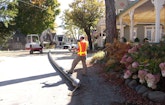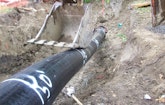
Interested in Municipal/Industrial?
Get Municipal/Industrial articles, news and videos right in your inbox! Sign up now.
Municipal/Industrial + Get AlertsMatt Timberlake is a true businessman in every sense of the word.
He knows when to take on a pipe bursting project and when to bypass and move onto the next one. He’s cognizant what’s good for his company and knows what needs to be done for the client. In the end, Timberlake, who is the vice president of Ted Berry Company in Livermore, Maine, makes sure clients get exactly what they’re paying for and everyone is happy.
That relationship starts right from the top during the bidding process.
“Bidding really is a game to some extent,” Timberlake says. “You’re looking at a project and you’re trying to evaluate risk and you’re trying to anticipate your production and efficiencies and you’re trying to use every bit of experience you have. At the same time, you’re trying to break up your costs into the pay items that fit best and sometimes manage your risk best.”
Founded in 1972, the Ted Berry Company has a great deal of experience in both static and pneumatic pipe bursting systems, as well as sewer and water pipes ranging from 2 to 36 inches, notes Timberlake. When the company considers bidding on a pipe bursting job, Timberlake and his colleagues thoroughly assess the situation.
Performance vs. prescriptive specifications
“One thing we always want to identify is where the risk is or where the risk could be in a project,” Timberlake says. “Like any type of trenchless construction, there is always risk buried in the details of a project. So, one of the first things we want to look at is the specifications and we see two models of specifications with bursting.
“You see a performance specification, which will simply say, ‘Here’s the pipe, here’s what we want to put in, you propose a way to do it.’ We like performance specifications, because what they do is allow us to apply our experience and to use our knowledge to manage our risk and maximize efficiencies and productivity. Alternatively, probably half the work we bid on has prescriptive specifications, which means, ‘Here’s the pipe, here’s what we want done,’ and they essentially tell you how to do it.”
When municipalities include prescriptive specifications, it limits the contractor’s ability to manage and plan the project.
Managing expectations
When Timberlake and his team are confident they want to bid on a job, Timberlake makes sure the municipality has everything laid out for them before a question can even arise.
“We provide a great deal of detail in the bidding process because it is so essential for the people we’re working for to understand what we need, how we need it, how it works,” Timberlake says. “The requirement of pipe bursting, it’s like any form of construction, the devil is in the details. If I need to dig a pipe insertion tip, I can’t simply tell the owner, ‘You need to provide me with a pipe insertion tip.’ I need to say, ‘I need a pipe insertion tip at this location, with this width, with this depth, this length.’ We feel it’s critical to provide the detail of how we’re going to complete the project and what our needs are.”
Including as much detail as possible helps avoid surprises, Timberlake says. If a pneumatic hammer is going to be used for a job, the bid will note the decibel level and mention the duration of the noise, so area residents are aware of what will be taking place.
Hardly a detail is overlooked. Again, the more specific the better, according to Timberlake.
“I know contractors that disagree with that and feel like when they include detail, if something comes up in the field and they want to change or modify their approach, they feel that it’s harder to do that,” he says. “I’ve got one really good friend who’s a contractor and he says, ‘I want to be as vague as possible. That way, as I modify my plan along the way, I’m not asking to change anything.’ I actually understand that, but I don’t necessarily always agree with it. I like to be very clear. For me, trenchless construction, I don’t care what method you’re using, it’s all about managing the owner’s expectations.”
Ted Berry Company generates a lot of repeat clients in the New England area because of its detail-oriented approach. Timberlake says the company’s clients tend to be fair, and while they may not automatically agree with every proposal or approve every change order, he appreciates clients who conduct business the right way.
“The majority of places we work, we end up back in,” Timberlake says. “That’s one of the reasons we take so much effort up front in helping identify and manage expectations. We want the owners we’re working for to be left feeling that they got what they expected; they got it how they expected, got it on schedule, on budget. We’re going back to places we did our first pipe burst for 12 years ago, and we’re back doing work for them every year.”











